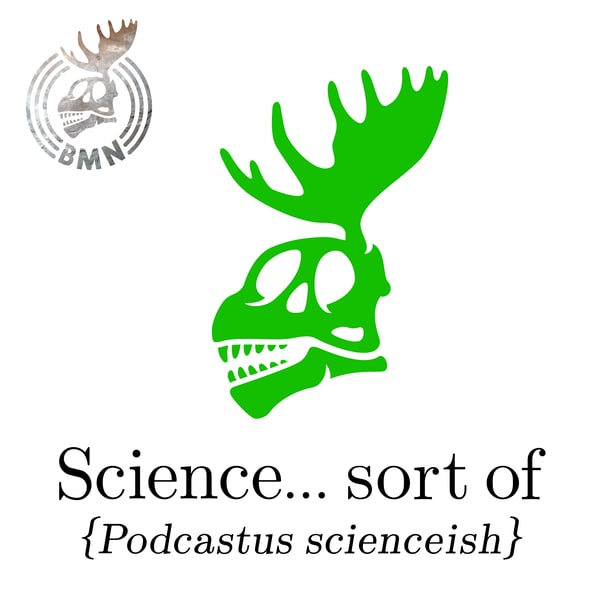Special Edition 14.2: AGU - Oceans and Outreach, Part 2
Science... sort of
Brachiolope
4.8 • 677 Ratings
🗓️ 10 January 2017
⏱️ 73 minutes
🧾️ Download transcript
Summary
More of Ryan bumming around a professional meeting, microphone in hand.
00:00:00 - First up is Stacey Felgate (@StaceyFelgate) and Kim Gottschalk (@Kim_Gottschalk). Stacey tells us a little bit about her work on blue carbon storage in salt marshes. Next, Kim tells us about her project investigating the source of Antarctic bottom water with GO-SHIP. They both also have a lot of recommendations for how to get involved in research as an undergrad, which you can learn about with these links:
- Woods Hole Oceanographic Institution
- NSF's Research Experiences for Undergraduates (REU)
- NSF's Louis Stokes Alliances for Minority Participation
- The Scottish Association for Marine Science (SAMS)
- Bermuda Institute of Ocean Sciences (BIOS)
00:23:04 - We end our AGU coverage shooting the breeze with our old friend Miles Traer (@Geo_Miles), who was also working the meeting from multiple angles and drawing cartoons the whole while. Per usual, the conversation strays from geoscience to pop culture asking the big questions like, "Could the Death Star really blow up a planet?" (Answer) and "Is Independence Day actually a good movie?" (Answer). At some point, Miles may even talk about the actual research he's been up to.
01:09:40 - PaleoPOWs are a lot like conferences, neither have enough coffee to go around. This week we're thanking Moe S. for his continued patronage and recent donation. Moe's reminds us that it's never too late to get an education and we thank him for being a loyal listener all these years. All the feels.
Thanks for listening and be sure to check out the Brachiolope Media Network for more great science podcasts!
Transcript
Click on a timestamp to play from that location
| 0:00.0 | All right, let's see if I can get through part two before the battery dies. |
| 0:04.0 | From science sort of.com, you're listening to Science Sort of. |
| 0:08.0 | Okay. |
| 0:09.0 | Hey there, Billy Opasi. This is Ryan here for part two of AGO Oceans and Outreach, 2016 time, part two. |
| 0:29.7 | Okay, so this time we have a great interview with Stacey Felgate and Kimberly Gottschalk about the work that they've done on carbon sequestration in salt marshes and deepwater mixing beneath Antarctica, respectively. |
| 0:49.5 | It was really great to talk with them. |
| 0:51.0 | It was a fun interview just over a couple of beers during AGU's traditional beer happy hour. And I think you're going to learn a lot and like what they |
| 0:57.8 | had to say. So give that a listen right now. |
| 1:14.3 | So we are being joined by Stacey Felgate and Kimberly Gottschalk. |
| 1:17.8 | Stacey is with the Scottish Association for Marine Science. |
| 1:20.7 | And Kim is with Portland State University. |
| 1:24.9 | And Stacey, you got in touch with me on Twitter because you wanted to talk a little bit about your work looking at carbon reservoirs in salt marshes. |
| 1:27.9 | Yeah. So this summer, I was lucky enough to go to Woods Hole to be a summer fellow. And I was |
| 1:32.8 | working with the USGS on the sustainability of salt marshes on Cape Cod. So my background is looking |
| 1:39.0 | at blue carbon, which is not a term I've ever heard before. Basically, they've called it blue carbon |
| 1:43.6 | because green carbon is carbon sequestered and terrestrial rainforest. |
| 1:46.5 | Blue is the ocean. |
| 1:47.5 | Oh, okay. |
| 1:48.5 | Yeah. |
| 1:49.5 | So any carbon that's taken up and stored for any long period of time in any ocean environment is called blue carbon. |
| 1:55.0 | I did not know that. |
| 1:56.0 | Yeah. |
... |
Please login to see the full transcript.
Disclaimer: The podcast and artwork embedded on this page are from Brachiolope, and are the property of its owner and not affiliated with or endorsed by Tapesearch.
Generated transcripts are the property of Brachiolope and are distributed freely under the Fair Use doctrine. Transcripts generated by Tapesearch are not guaranteed to be accurate.
Copyright © Tapesearch 2025.

